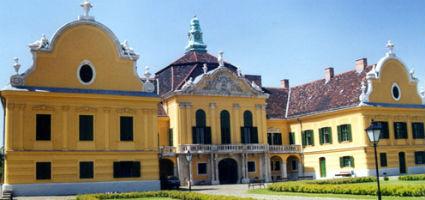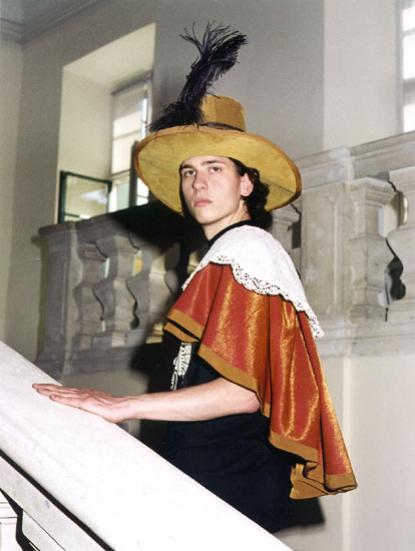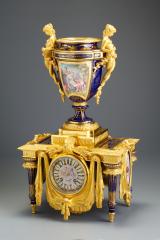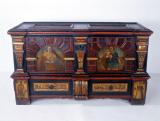2024. April 26. Friday
Castle of Nagytétény - Budapest
 |
One of the outstanding baroque buildings of Hungary is the Száraz-Rudnyánszky mansion, which bears the characteristics of the Grassalkovich type mansion houses. The building is divided by columns, pillars and chambers formed according to the demands of the age for rich light-shade effects. The demanding sculptural ornament is a worthy crown upon the building: the roofing resembling to a dome bears the coat-of-arms of the Száraz and Rudnyánszky families.
The history of the mansion is almost parallel with the history of the Hungarian nation. In site of the castle there had stood a Roman 'villa rustica', which had belonged to a businessman. In the medieval times the remains of the villa were built in the fundamental walls of the mansion. Its gate stone looking to the west is still there in the cellar of the mansion. According to suppositions the core of the present building (together with the Roman remains) had been built during the 13th century for the Tétény family. Around 1309 the captain of Buda Castle Lőrinc Tétény Hédervári became the owner of the mansion. His family owned the building for more than two centuries, during which time it was extended into an L shape.
During the time of the Turkish occupation (1541-1686) Tétény was directly placed under the supremacy of the sultan. Authoritative Turkish officers lived in the building at this time. In 1686 the mansion was given to Captain Ferenc Buchingen, in return for his heroic fight in the battles for liberation. Later it was purchased by György Száraz.
György Száraz began extension and renovation works on the building in 1716. By keeping the medieval walls he built a connection wing to the tower on the south-east side.
After the death of György Száraz, his son-in-law became the new owner who modernised and rebuilt the mansion into an aristocratic residence. After 1798 the mansion was inherited by three descendants and as such was divided into three different parts. In its south-west division the French lady owner founded an orphanage that can be regarded as the predecessor of the Habilitation Institute still operating in the mansion house today.
The building burnt out in 1904, and its original furnishing was destroyed. During the World War II the mansion suffered serious damages again. After 1945 the ex-owner Géza Dáni's idea of holding exhibitions of applied arts in the building was shared by the leader of the Museum of Applied Arts, Pál Voit. In 1948 the Ministry of Agriculture (in control of the area) gave the mansion over for museologic purposes. Renovation works began in 1951.
Because of the worsening of the conditions of the building the castle museum had to shut down in 1990. It was in the summer of the year 2000 that the museum again opened its gates to the general public on the occasion of a furniture exhibition held to celebrate the millennium.
Elvira Király
Director of the castle museum
The history of the mansion is almost parallel with the history of the Hungarian nation. In site of the castle there had stood a Roman 'villa rustica', which had belonged to a businessman. In the medieval times the remains of the villa were built in the fundamental walls of the mansion. Its gate stone looking to the west is still there in the cellar of the mansion. According to suppositions the core of the present building (together with the Roman remains) had been built during the 13th century for the Tétény family. Around 1309 the captain of Buda Castle Lőrinc Tétény Hédervári became the owner of the mansion. His family owned the building for more than two centuries, during which time it was extended into an L shape.
During the time of the Turkish occupation (1541-1686) Tétény was directly placed under the supremacy of the sultan. Authoritative Turkish officers lived in the building at this time. In 1686 the mansion was given to Captain Ferenc Buchingen, in return for his heroic fight in the battles for liberation. Later it was purchased by György Száraz.
György Száraz began extension and renovation works on the building in 1716. By keeping the medieval walls he built a connection wing to the tower on the south-east side.
After the death of György Száraz, his son-in-law became the new owner who modernised and rebuilt the mansion into an aristocratic residence. After 1798 the mansion was inherited by three descendants and as such was divided into three different parts. In its south-west division the French lady owner founded an orphanage that can be regarded as the predecessor of the Habilitation Institute still operating in the mansion house today.
The building burnt out in 1904, and its original furnishing was destroyed. During the World War II the mansion suffered serious damages again. After 1945 the ex-owner Géza Dáni's idea of holding exhibitions of applied arts in the building was shared by the leader of the Museum of Applied Arts, Pál Voit. In 1948 the Ministry of Agriculture (in control of the area) gave the mansion over for museologic purposes. Renovation works began in 1951.
Because of the worsening of the conditions of the building the castle museum had to shut down in 1990. It was in the summer of the year 2000 that the museum again opened its gates to the general public on the occasion of a furniture exhibition held to celebrate the millennium.
Elvira Király
Director of the castle museum


